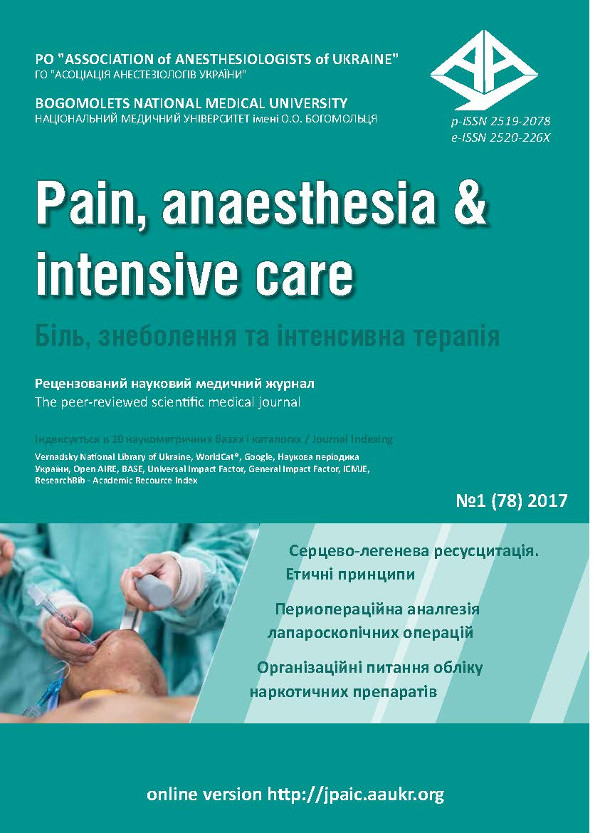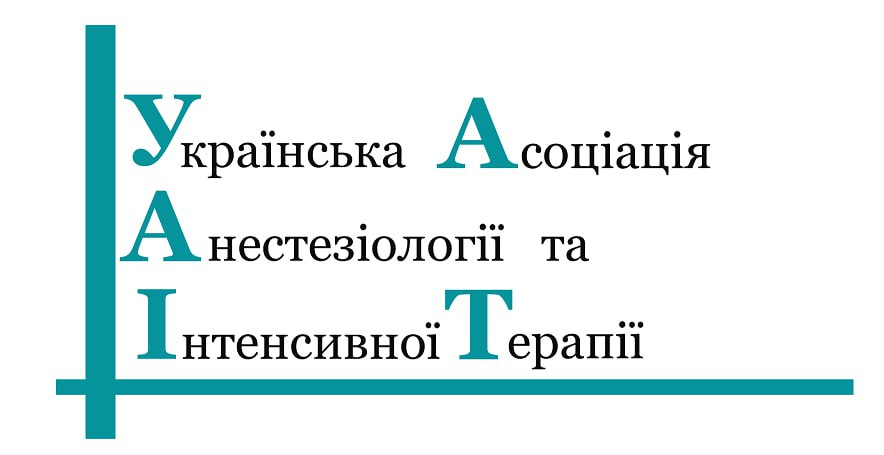Режими керованої вентиляції легенів на етапах хірургічного лікування хворих з морбідним ожирінням (Огляд літератури)
DOI:
https://doi.org/10.25284/2519-2078.1(78).2017.103179Ключові слова:
морбідне ожиріння, дихальна система, режими керованої вентиляції легенівАнотація
В статті наведено літературний огляд сучасного стану проблеми інтраопераційного застосування різних режимів і методик керованої вентиляції легенів у пацієнтів з морбідним ожирінням (МО). Підтримання адекватної оксигенації і уникнення пошкодження легенів при проведенні інтраопераційної штучної вентиляції легенів (ШВЛ) продовжує залишатися серйозною проблемою у хворих з МО і не до кінця вирішеною. Багато дискутабельного відносно режимів вентиляції, немає чіткості і в питаннях сприятливого положення пацієнта, оптимального рівня позитивного тиску в кінці видиху (ПТКВ) під час здійснення преоксигенації. Вважається, що різниці між використанням ШВЛ з контролем за тиском та об’ємом немає – обидва режими в однаковій мірі впливають на газообмін, тиск в дихальних шляхах і середній артеріальний тиск. Як що дослідники не відмічають різниці проведення керованої вентиляції з контролем за тиском і об’ємом у пацієнтів з ІМТ до 50 кг/м2, то дані відносно пацієнтів з суперожирінням відсутні. Не проводились масштабні дослідження з достатньо доказовою базою, які могли лягти в основу протоколів (як от Cochran collaboration). Ці невирішені питання є підставою розробки вітчизняних рекомендацій щодо ШВЛ під час операцій у хворих на МО.Посилання
Obesity: A medical history/ D. Haslam //Obes Rev.- 2007.- Vol.8(Suppl 1).- P.31-36. https://doi.org/10.1111/j.1467-789x.2007.00314.x
 |
| 
Prevalence of obesity in the United States /M.L. Baskin, J. Ard, F. Franklin [ et al.]// Obes Rev.- 2005.-Vol.6.- P.5-7. https://doi.org/10.1111/j.1467-789x.2005.00165.x
 |
| 
Extreme obesity: A new medical crisis in the United States /D.D. Hensrud, S. Klein // Mayo Clin Proc.- 2006.-Vol.81 (10 Suppl). S.5-S10. https://doi.org/10.1016/s0025-6196(11)61175-0
 |
| 
Challenges in obesity epidemiology/ D. Canoy, I. Buchan//Obes Rev.- 2007.-Vol.8 (Suppl 1).-P.1-11. https://doi.org/10.1111/j.1467-789x.2007.00310.x
 |
| 
http://www.info.com. - 1997.
Bariatric surgery worldwide 2003 / H. Buchwald, S.E. Williams // Obes. Surg. – 2004.-Vol.14.- P.1157–64. https://doi.org/10.1381/0960892042387057
 |
| 
Гастрошунтированое в хирургии морбидного ожирения / Ю.И.Юшков // Анналы хирургии. - 2006. - No 2. - С. 40-42.
Баріатрична хірургія: історія до сьогодення / А.С.Лаврик // Клінічна хірургія. – 2012.- No 6.- С.5-10.
Excess deaths associated with underweight, overweight, and obesity/ K.M. Flegal, I.B. Graubard, D.F. Williamson [et al.]// JAMA. - 2005. – V.293, N 4. - P.1861-1967. https://doi.org/10.1001/jama.293.15.1861
 |
| 
Лікування хворих на цукровий діабет з діабетичною енцефалопатією / І.В. Паньків // К.: Здоров’я України 21 ст. - 2006. - No6. - С.57.
Консервативное лечение ожирения / В.П.Буханов. М.: Медицина , 2011.- С.28-32.
Obesity, obstructive sleep apnoea, and diabetes mellitus: anaesthetic implications/ K. Candiotti, S. Sharma, R. Shancar // Br J anaesth. - 2009. - Vol.103 (Suppl 1). - P.23-30. https://doi.org/10.1093/bja/aep294
 |
| 
Obesity and obstetric anesthesia / K. Saravanakumar, S.G. Rao, G.M. Cooper // Anethesia.-2006.-Vol.61.-P.36-48. https://doi.org/10.1111/j.1365-2044.2005.04433.x
 |
| 
Ventilation strategies in obese patients undergoing surgery: a quantitative systematic review and meta-analysis/ M. Aldenkortt, C. Lysakowski, N. Elia [et al.]// Br J Anaesth.- 2012.-Vol.109, N4.- P.493-502. https://doi.org/10.1093/bja/aes338
 |
| 
Surgery in morbidly obese/ C.M. Matadial, J.H. Slonin// Complication in Anesthesia Elsevier.- 2007.-Vol.4.-P.810-813. https://doi.org/10.1016/b978-1-4160-2215-2.50207-6
Manometric abnormalities and gastroesophageal reflux disease in the morbidly obese/ D. Hong, Y.S. Khajanchee, N. Pereira // Obes Surg.- 2004.- Vol.14.- P.744-749. https://doi.org/10.1381/0960892041590854
 |
| 
Obesity and the airway/ M. Bellomy, M. Struys// Anaesthesia for the overweight and obese patient.- Oxford.-2007.- P.75-82. https://doi.org/10.1093/med/9780199233953.003.0009
Pulmonary atelectasis: a pathogenic perioperative entity / M. Duggan, B.P. Kavanagh // Anesthesiology.-2005.-Vol.102.-P.838-854. https://doi.org/10.1097/00000542-200504000-00021
 |
| 
The effects of anesthesia and muscle paralysis on the respiratory system/ G. Hedenstierna, L. Edmark //Intensive Care Med.-2005.- Vol.31.- P.1327-1335. https://doi.org/10.1007/s00134-005-2761-7
 |
| 
Effect of obesity on safe duration of apnea in anesthetized humans / H.G. Jense, S.A. Dubin, P.I. Silverstein [et al.] // Anesth Analg.- 1991.- Vol.72.- P. 89-93. https://doi.org/10.1213/00000539-199101000-00016
 |
| 
How to inform a morbidly obese patient on the specific risk to develop postoperative pulmonary complications using evidence-based methodology/ S. Flier, T.A. Knape // Eur J Anaesth.- 2006.- Vol.23.-P.154-159. https://doi.org/10.1017/s0265021505002073
 |
| 
Prevention of atelectasis formation during the induction of general anesthesia in morbidly obese patients/ M.Coussa, S. Proietti, P. Schnyder [et al.] //Anesth Analg. - 2004.-Vol.98.-P. 1491-1495. https://doi.org/10.1213/01.ane.0000111743.61132.99
 |
| 
Effectiveness of continuous positive airway pressure to enhance pre-oxygenation in morbidly obese women / D.M. Gressey, M.C. Berthoud, C.S. Reilly// Anaesthesia.-2001.- Vol.56.- P.680-684. https://doi.org/10.1046/j.1365-2044.2001.01374-3.x
 |
| 
Positive end-expiratory pressure during induction of general anesthesia increases duration of nonhypoxic apnea in morbidly obese patients / S. Gander, P. Frascarolo, M. Suter [et al.]// Anesth Analg.- 2005.- Vol.100.-P. 580-584. https://doi.org/10.1213/01.ane.0000143339.40385.1b
 |
| 
Preoxygenation is more effective in the 25 degrees head-up position than in the supine position in severely obese patients: A randomized controlled study / B.J. Dixon,J.B. Dixon, J.R. // Anaesthesiology.-2005.- Vol. 102.- P.1110-1115. https://doi.org/10.1097/00000542-200506000-00009
 |
| 
Positioning the morbidly obese patient for anesthesia / J.B. Brodsky// Obes Surg .- 2002.- Vol.12.- P.751-758. https://doi.org/10.1381/096089202320995510
 |
| 
Postoperative complications in obese and nonobese patients/ O.A. Bamgbade, T.W. Rutter, O.O. Nafiu [et al.]// World J Surg .- 2007.- Vol. 31.- P.556-560; discussion 561. https://doi.org/10.1007/s00268-006-0305-0
 |
| 
Total respiratory system, lung, and chest wall mechanics in sedated-paralyzed postoperative morbidly obese patients / P. Pelosi, M. Croci, I. Ravagnan [et al.] // Chest.- 1996.-Vol.109.-P. 144-151. https://doi.org/10.1378/chest.109.1.144
 |
| 
Breathing mechanics, dead space and gas exchange in the extremely obese, breathing spontaneously and during anaesthesia with intermittent positive pressure ventilation/ G. Hedenstierna, J. Santesson // Acta Anaesthesiol Scand. - 1976.-Vol.20.- P.248-254. https://doi.org/10.1111/j.1399-6576.1976.tb05036.x
 |
| 
Rochester D.F. Obesity and abdominal distension. The Thorax, part C: Disease, 2nd Ed / D.F.Rochester. - New York, Marcell Dekker,1995.- pp. 1951-1973.
Effects of short-term pressure-controlled ventilation on gas exchange, airway pressures, and gas distribution in patients with acute lung injury/ARDS: comparison with volume-controlled ventilation/ M. Prella, F. Feihl, G. Domenighetti // Chest.-2002.- Vol.122.-P. 1382-1388. https://doi.org/10.1378/chest.122.4.1382
 |
| 
Prospective randomized trial comparing pressure-controlled ventilation and volume-controlled ventilation in ARDS. For the Spanish Lung Failure Collaborative Group/ A. Esteban, I. Alia, F. Gordo [et al.] // Chest.-2000.- Vol.117.-P. 1690-1696. https://doi.org/10.1378/chest.117.6.1690
 |
| 
Postoperative considerations for patients with obesity and sleep apnea/ R.L. Bell, S.H. Rosenbaum // Anesth Clin North America.- 2005.- Vol.23,N 3.- P. 493-500. https://doi.org/10.1016/j.atc.2005.03.007
 |
| 
Are pulse oximetry and end-tidal carbon dioxide tension monitoring reliable during laparoscopic surgery? / J.B. Nyarwaya, J.X. Mazoit, K. Samii// Anaesthesia. -1994. - Vol.49. - P.775-778. https://doi.org/10.1111/j.1365-2044.1994.tb04449.x
 |
| 
Mild hypercapnia increases subcutaneous and colonic oxygen tension in patients given 80% inspired oxygen during abdominal surgery/ E. Fleischmann, F. Herbst, A. Kugener [et al.] // Anesthesiology. - 2006. - Vol. 104.- P. 944-949. https://doi.org/10.1097/00000542-200605000-00009
 |
| 
Hypercapnia improves tissue oxygenation in morbidly obese surgical patients/ H. Hager, D. Reddy, G. Mandadi [et al.]// Anesth Analg.-2006.- Vol.103.- P.677-681. https://doi.org/10.1213/01.ane.0000229715.71464.90
 |
| 
Comparison of volume control and pressure control ventilation: is flow waveform the difference? K. Davis Jr., R.D. Branson, R.S. Campbell [et al.] // J Trauma. - 1996. - Vol.41. - P. 808-814. https://doi.org/10.1097/00005373-199611000-00007
 |
| 
Large tidal volume ventilation does not improve oxygenation in morbidly obese patients during anesthesia / G.L. Bardoscky, J.C. Yernault, J.J. Houben [et al.] //Anesth Analg. - 1995. - Vol.81. - P. 385-388. https://doi.org/10.1097/00000539-199508000-00030
 |
| 
Obesity in anaesthesia and intensive care / J.P. Adams, J.P. Murphy // Br J Anaesth. - 2000. - Vol.85.- P. 91-108. https://doi.org/10.1093/bja/85.1.91
 |
| 
Анестезиологическое обеспечение лапароскопических вмешательств: проблема пневмоперитонеума / В.М.Мизиков, У.Б.Батыров // Анестезиология и реаниматология. - 1995. - No 3. - С. 44-48.
The “Hide-bound” Bowel Sign / P.J. Pickard // Radiology. - 2010. - Vol. 213. - P. 837-838. https://doi.org/10.1148/radiology.213.3.r99dc21837
 |
| 
Inverse ratio ventilation compared with PEEP in adult respiratory failure/ A.G. Cole, S.F. Weller, M.K. Sykes // Intensive Care Med. - 1984. - Vol. 10. - P. 227-232. https://doi.org/10.1007/bf00256258
 |
| 
Pressure controlled inverse ratio ventilation in severe adult respiratory failure/ R.S. Tharratt, R.P. Allen, T.E. Albertson // Chest. - 1988. - Vol.94.- P. 755-762. https://doi.org/10.1378/chest.94.4.755
 |
| 
Prevention of atelectasis in morbidly obese patients during general anesthesia and paralysis: a computerized tomography study/ H. Reinius, L. Jonsson, S. Gustafsson [et al.] // Anesthesiology. - 2009. - Vol.111. - P.979-987. https://doi.org/10.1097/aln.0b013e3181b87edb
 |
| 
The effects of pneumoperineum on respiratory mechanics during general anesthesia for bariatric surgery / A.A. Dawlatly, A. Dohayan, M.E. Abdel – Meguid [et al.] // Obes Surg. - 2004. - Vol .14. - P. 212-215. https://doi.org/10.1381/096089204322857582
 |
| 
The effects of the alveolar recruitment maneuver and positive end-expiratory pressure on arterial oxygenation during laparoscopic bariatric surgery / F.X. Whalen, O. Gajic, G.B. Thompson [et al.] // Anesth Analg. - 2006. - Vol.102. - P.298-305. https://doi.org/10.1213/01.ane.0000183655.57275.7a
 |
| 
Positive end-expiratoty pressure optimization using electric impedance tomography in morbidly obese patients during laparoscopic gastric bypass surgery/ K. Erlandsson, H. Odenstedt, S. Lundin [et al.] //Acta Anaeshesiol Scand. - 2006. - Vol.50. - P.833-839. https://doi.org/10.1111/j.1399-6576.2006.01079.x
 |
| 
Positive end-expiratory pressure improves respiratory function in obese but not in normal subjects during anesthesia and paralysis / P. Pelosi, I. Ravagnan, G. Giurati [et al.] //Anesthesiology. - 1999. - Vol.91. - P.1221-1231. https://doi.org/10.1097/00000542-199911000-00011
 |
| 
Intraoperative recruitment maneuver reverses detrimental pneumoperitoneum – induced respiratory effects in healthy weight and obese patients undergoing laparoscopy / E. Futier, J.M. Constantin, P. Pelosi [et al.] // Anesthesiology. - 2010. - Vol.113. - P. 1310-1319. https://doi.org/10.1097/aln.0b013e3181fc640a
 |
| 
##submission.downloads##
Опубліковано
Як цитувати
Номер
Розділ
Ліцензія
Авторське право (c) 2017 А. П. Мазур, О. В. Винниченко, В. М. Шевченко, О. Ф. Бубало

Ця робота ліцензується відповідно до Creative Commons Attribution-NonCommercial 4.0 International License.
Автори, які публікуються у цьому журналі, погоджуються з наступними умовами:
a. Автори залишають за собою право на авторство своєї роботи та передають журналу право першої публікації цієї роботи на умовах ліцензії Creative Commons Attribution-NonCommercial 4.0 International License, котра дозволяє іншим особам вільно розповсюджувати опубліковану роботу з обов'язковим посиланням на авторів оригінальної роботи та першу публікацію роботи у цьому журналі.
b. Автори мають право укладати самостійні додаткові угоди щодо неексклюзивного розповсюдження роботи у тому вигляді, в якому вона була опублікована цим журналом (наприклад, розміщувати роботу в електронному сховищі установи або публікувати у складі монографії), за умови збереження посилання на першу публікацію роботи у цьому журналі.
c. Політика журналу дозволяє і заохочує розміщення авторами в мережі Інтернет (наприклад, у сховищах установ або на особистих веб-сайтах) рукопису роботи, як до подання цього рукопису до редакції, так і під час його редакційного опрацювання, оскільки це сприяє виникненню продуктивної наукової дискусії та позитивно позначається на оперативності та динаміці цитування опублікованої роботи (див. The Effect of Open Access).








